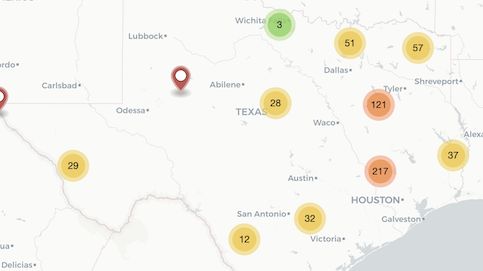TEXAS — In 1878, a young white woman named Fannie McGuire fell in love with Walter Dering, an 18-year-old Black man who worked on her father’s property in Walker County. The couple, wanting to escape the disapproving public eye, moved to Houston. But McGuire’s father sent her brothers to look for them, and when they found them, they accused Dering of pulling a gun on the brothers. The police arrested Dering, and he was taken back to Riverside in Walker County.
Dering was later killed by an armed mob in a tale of racial violence that happened so frequently in the American South, and particularly Texas, that a decade after this incident, the Chicago Tribune began documenting lynchings across the country. Years later, researchers with the NAACP and the Tuskegee Institute followed suit, giving historians voluminous archives of lynchings that continued to occur well into the 20th century.
Now, a new Texas-based project is trying to document more than 700 lynchings in the Lone State State on a website with an interactive map and detailed historical accounts and records of each event.
The website, called Lynching in Texas, was started by Dr. Jeff Littlejohn, a history professor at the Sam Houston State University in Huntsville. The project’s idea is to make the information accessible and, more importantly, readable for anyone interested in learning more about this horrific part of the state’s past.
It is by no means the first documentation of the state’s lynching history, and plenty of historians have focused books on the topic, Littlejohn said. “But how many people are going to go to the library and check out one of these books? We’re trying to make the information accessible to a wider public.”
The website project is run by Littlejohn and several history grad students at the university in Huntsville, with funding from the university and Humanities Texas.
The researchers define lynching using four criteria. First, there must be legal evidence that a person was killed. That person must have met death illegally. A group of three or more persons must have participated in the killing. And lastly, the group must have acted under the pretext of service to justice, race, or tradition.
Using these four benchmarks, researchers then comb through existing archives of lynchings, then search for newspaper clippings to find more details about the events. That means checking not just the white newspapers but the Black and Hispanic newspapers of the day as well. The minority newspaper’s reporting of the events typically varies greatly from the writeups in the newspapers’ traditionally white subscribers.
Because Texas also has a long history of Hispanic newspapers, researchers at the Lynching in Texas website have managed to uncover previously underreported cases of Hispanics being lynched in the state.
“What makes Texas so different from the rest of the South is that Texas isn’t a white and Black state, and therefore lynching in Texas wasn’t just white and Black,” Littlejohn said.
The research team is currently seeking funding to expand its timeframe of 1882 to 1942 to include lesser-known stories of victims of lynchings that occurred prior to that period, such as the fate of Walter Dering, the young Black man from Walker County.
Once Dering returned to Walker County in 1878, he was taken to a vacant house in Riverside that was being used as a temporary jail. There, he was put in a neck chain and secured to the building’s floor. That night, according to a report in the April 20, 1878, edition of the Marshall Messenger in Marshall, Texas, “a mob of about 20 armed men proceeded to the temporary jail, and forcing it open, fired the contents of their guns into the body of the prisoner, which was entirely riddled with buckshot."
The report said he was then beaten to death.



